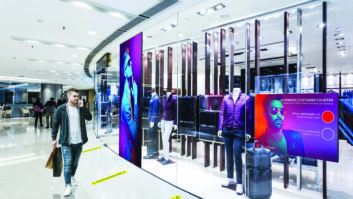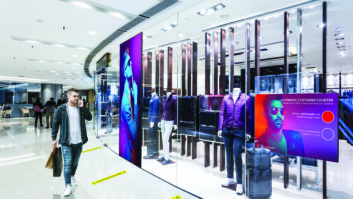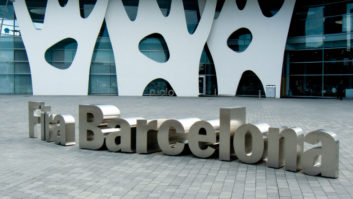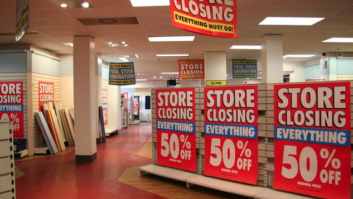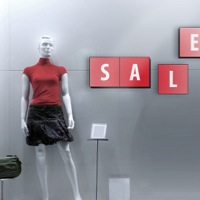
Those who trace the threat to ‘bricks and mortar’ retailing to the ubiquity of internet access are perhaps mistaken. There is a case for saying that the threat first emerged in 1977, when a US talk radio show host sold 112 can openers to his listeners in an hour. The radio station owner sensed an opportunity, going on to found the Home Shopping Network – which in turn spawned an entire industry. What bricks and mortar jeweller could compete with diamonds as big as a TV screen? Which high street store could present a set of saucepans in such excruciating detail?
There is, though, little doubt that the internet is proving a much more significant threat. Retailers and shopping centres are, however, fighting back.
“The growth in multimedia, web and mobile technologies in recent years has made it almost compulsory for many retailers to venture into this arena,” says Richard Edwards, senior consultant at retail design consultancy Javelin Group. “So many more customers now have a wide choice in the ways in which they can engage with a retailer that not to offer that choice may leave them soon lagging behind the competition.”
Tremendous growth
“A recent review of high street and out-of-town stores has shown a tremendous growth in the amount of multichannel hardware visible in-store,” he continues.
“There needs to be a reason to enter the physical store and AV technology can certainly support that effort,” notes Steve Seminario, senior product marketing manager for Planar Systems. “The use of digital displays in retail is typically designed to attract traffic, communicate brand, create ambiance, engage shoppers, articulate an offer. Implemented successfully, any of those five uses enhances the physical store experience.”
It’s important to understand: AV technology in retail is more – much more – than digital signage. Digital signage is – mostly – about communicating factual information.
“The focus of in-store signage is no longer just functional for directing or advertising,” says Steve Scorse, vice president EMEA for Prysm, whose installation at Burberry’s flagship store in London is widely recognised as being a key element in a store that has done more than most to leverage AV technology (see case study, page 18). “Branding is now seen as a separate function to digital signage. It helps to create the experience, giving a sense of arrival and reinforcing brand values to consumers when they are in the retail space. We now need to create experiences which give something extra and create a talking point which can spread through word of mouth, social media and PR.”
“Some of the most innovative uses of AV technology in retail centre around the use of displays as integral parts of the space – almost as a building material,” continues Seminario. “Other innovative uses take advantage of the inherent flexibility of digital displays – now it’s informing me, now it’s making an offer, now it’s entertaining me, now it’s part of a co-ordinated branding experience running across the entire store, now it’s part of the store infrastructure.”
Experiencing the brand
Increasingly, retailing is about the brand – and the brand experience can be difficult to convey via a simple PC screen, something that switched-on retailers are recognising. Helping create the brand image is a challenge for AV companies. Accurate colour reproduction, for example, is much more important in branding than it is in digital signage – a point made by Scott Pickus, marketing manager at DynaScan, whose company has developed displays specifically for the retail environment.
“We’ve paid special attention to colour quality,” he says, “ensuring that our displays deliver a true white. All of our high-brightness LCDs are individually colour calibrated to the D65 colour standard which has a colour correlation to natural daylight.” He also notes that the retail displays designed by DynaScan feature high brightness and 24/7 operation capability.
It’s not just about video. Audio too has a key role to play in creating ‘the brand atmosphere’.
“The requirement we most frequently see is for high-clarity room-filling sound with even sound pressure to create an ambience appropriate to the brand,” says Babs Moore, sales director at Amina Technologies. “In such places, it is unusual for the music to be played particularly loudly, but an even ambience is important. Amina Invisible loudspeakers are designed for locations where aesthetics are key, and ugly ‘dinner plate’ ceiling loudspeakers impact the design in an unacceptable manner. Amina retail customers are typically those focused at the very high end of the market where aesthetics are a key part of the experience.”
Innovation
More and more, it seems that AV is being designed in to stores, rather than bolted on as an afterthought – and AV applications are becoming more innovative.
“We work on a lot of bespoke projects, so a brand and their agency will approach us with a concept and we will work alongside them to technically deliver it,” says Neil Manwaring, sales and operations director at integrator Arcstream AV. “Recently, we worked with Vauxhall to produce a screen on rails which revealed the interior of the car as it moved past each part of the vehicle. We have created a huge touchwall which lit up a whole Sony store in the correlating colours to the laptop which was chosen by shoppers in Manchester.”
“Retail theatres are a new trend that we are seeing start to emerge, particularly within the automotive and high-end fashion sectors,” adds Scorse. “No products are on show within this space, so the focus is on interactive technologies to create the experience and gain people’s interest, with products being shown later in the journey. I think we will continue to see a rise in interactive displays being used to create a sensory experience which can also extend the consumer journey by linking with an online strategy.”
“The important thing, and what we always try to do, is to understand what the customer is trying to achieve,” points out Chris Bartram, managing director of Crystal Display Systems whose retail product range offers transparent displays – including displays for food/drink retail refrigerator glass doors – battery-powered displays and shelf-edge displays. “It’s got to be about more than just novelty value.”
‘Transparent’ seems to be catching on: Bartram notes that such displays have been used by Harrods, Casio and Nike among others. “Our EYE-LCD transparent displays are ideal for retail environments, because they can be used to combine digital information with real-world objects,” says Eric Hénique, director of marketing and international sales at eyevis. He goes on to note the creative possibilities offered to retailers by his company’s omniSHAPES and squareTILES which allow images of almost any size or shape to be created.
Other AV innovations for the retail industry include Comqi’s delayMirror, a ‘video mirror’ that provides a continual delayed video feed which enables shoppers to see themselves as they were three seconds ago, allowing them to twirl and see the clothes they are wearing from all angles in a dressing room. Importantly, it gives customers an experience they can’t get online.
Fashion retailer New Look recently launched what it calls an “augmented retail experience” at its Marble Arch, London store, in which the Blippar mobile phone image recognition app is used to allow consumers to interact with model Kelly Brook’s new range of cosmetics. The concept is expected to roll out to over 700 stores across Europe.
New Look is a perfect example of how the holy grail for retailers and brands is to engage consumers, to interact with them and to create something close to a personal, one-to-one relationship. Now, consumers are not being advertised to – they’re being communicated with. Here too, AV technology is playing a key role.
“Interactivity is an important element of data capture, increasing social media reach for brands and it helps to create a real physical link with the consumer which strengthens brand recall,” says Arcstream’s Manwaring. “It also enables you to record consumer choices and then use this to improve uptake, range or your retail strategy for the future.”
Creating relationships – and buyers
“I think we will see a big growth of intelligent control solutions within AV in retail for 2013,” adds Prysm’s Scorse. “RFID is one particular method which is already advancing and being used to track movements around the store, identify which items made people stop, what they viewed and for how long. This will develop into more advanced ideas along with data capture in other forms to build a profile of the person such as age, ethnicity and body shape, so personalised recommendations can be made alongside the style choices they make in-store.”
In other words: interactivity isn’t just for fun or to entertain consumers. Done right, it can directly influence shopping behaviour – and capture information that makes it possible to create, not just a customer, but a loyal fan. And, as eyevis’s Hénique points out, customers don’t come to a store to watch promotional videos.
Working together
The fact is, however, that while web-based shopping and store-based shopping may appear to be competitors, for most retailers and brands, the two are complementary rather than mutually exclusive. “Most retailers have both a physical presence and a web presence,” says Edwards. “The technology enables them to share those environments between each other, where the store can promote range and product information from the internet and web-based customers can be given the choice of buying online and collecting from a store near them, at a time that suits them.”
“Increasingly, shoppers bring the online experience into the store with them on their phone,” points out Seminario. “But there’s a reason they’re in the store and not just online. Leading-edge retailers are exploring ways to maximise the useful interplay between those handheld digital devices and the physical store shopping experience. A key piece of those leading-edge solutions is the in-store digital displays and AV infrastructure that facilitates bidirectional communication between the shopper’s device and the store.”
But for as long as retailers have stores – even if they have a strong online presence – they need to encourage a steady flow of consumers into them. “Bricks and mortar retailers are being forced to adapt to the online shopping experience to keep their customers,” says DynaScan’s Pickus. “The majority of people will buy when the product is presented in a unique way, which excites them into the purchase. Retailers can use AV technology in several ways including brand building, elements of interactivity, and attention-grabbing features to create an environment that people want to go to. The more interest that is created using AV technology that allows customers to touch and feel the actual product, the higher the chance for the shopper to buy.”
‘Retail therapy’ is a tongue-in-cheek description of the pleasure that many get from shopping. With the help of AV technology, that experience is unquestionably being revitalised, bringing consumers back into stores and, most importantly, helping to increase sales.
www.amina.com
www.arcstreamav.com
www.crystal-display.com
www.dynascan.com
www.eyevis.de
www.javelingroup.com
www.planar.com
www.prysm.com
www.sony-europe.com
